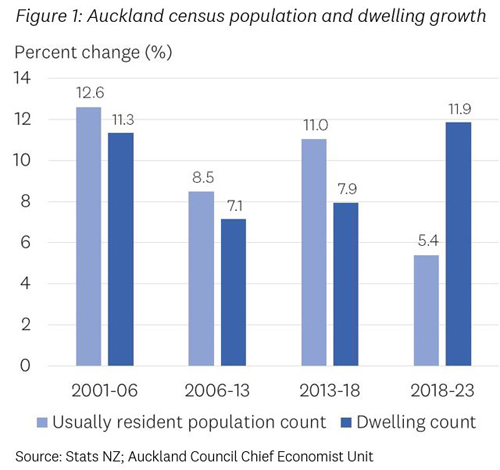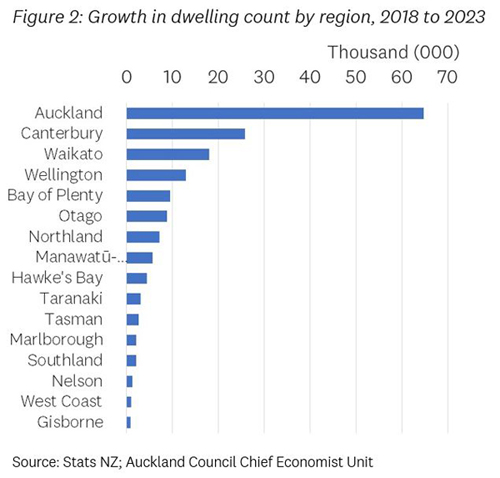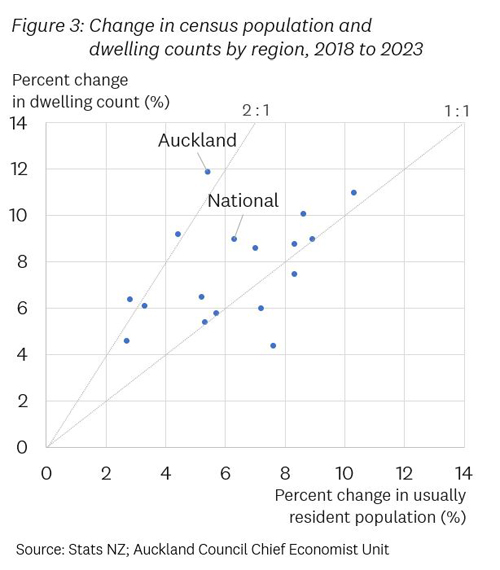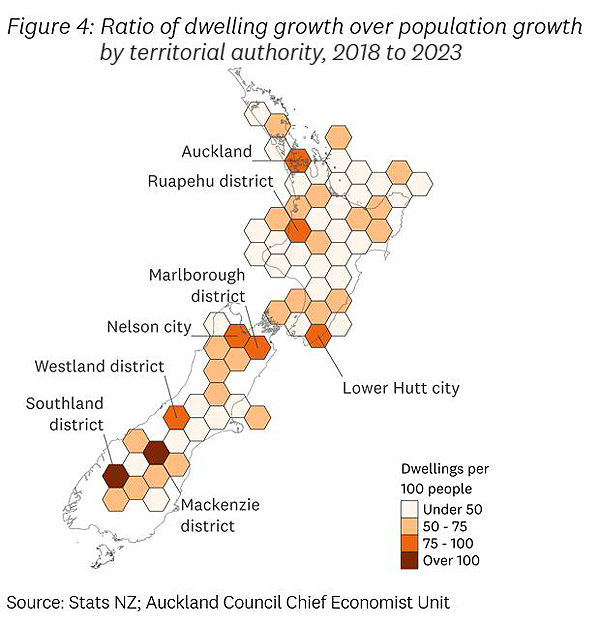
This is a press release from Auckland Council.
Auckland Council’s Chief Economist presents visual data that paints a vivid picture of Auckland’s progress in tackling its housing needs, with the Census 2023 results revealing a striking shift in new homes built since 2018.
Chief Economist Gary Blick notes that the period between the last census in 2018 and the 2023 results has been shaped by the Auckland Unitary Plan – the city’s planning rulebook. Its bold changes to boost housing capacity and choice have significantly impacted the city's housing landscape, making Census 2023 the first to fully account for its impact in Auckland.
“The census results show how the council's changes to land use rules, to allow for more housing per site, have sparked a surge in new housing, with 64,800 new homes built between 2018 and 2023. That’s a remarkable 11.9 per cent increase in new homes compared to a 5.4 per cent increase in population, meaning we have more new homes relative to our population than before,” says Blick.
“Even after recovering from the pandemic-related population loss over 2020 to 2022, this confirms what we’ve seen in building consent data and population estimates – Auckland has built a lot of homes in recent years relative to its population growth,” he says.
“The new census results are also consistent with University of Auckland research, showing that the Unitary Plan has led to more housing choice and more new homes than would otherwise have been the case.
“The Unitary Plan has expanded how residential land can be used to allow for a greater variety of housing, providing more choices in housing type and location. As a result, we’ve seen more new homes, which has helped housing affordability to be better than otherwise. However, Auckland housing remains expensive relative to incomes and policies allowing for even more housing will be vital to addressing this,” says Blick.
Read more: Auckland upzoning sparks more homes and improved affordability.
You need to see it to believe it
Visual data highlights Auckland's substantial progress in increasing its housing supply, showing it has outperformed other regions in comparison.
Figure 1: This compares the housing growth rate versus the usually resident population growth rate between 2018 and 2023, with those for past censuses.
It highlights the significant reversal of the decades-long trend where the population growth rate outpaced the housing growth rate in each period between censuses.

Figure 2: This shows that Auckland had the highest growth in new housing in New Zealand between 2018 and 2023, far surpassing all other regions.
The next closest was Canterbury, with almost 26,000 new homes.

Figure 3: This demonstrates how different regions responded to additional housing demand by comparing the increase in homes to population growth.
Auckland was a top performer, with an 11.9 per cent increase in the number of new homes over its 2018 total, and more than double its population growth percentage.
In comparison, the equivalent percentage increase in new homes for the rest of New Zealand (excluding Auckland) was 7.1 percent.

Figure 4: This examines different local government areas using a ratio of change in housing numbers to population growth. The ratio shows the number of additional homes added per 100 people, providing insight into how well the housing supply is meeting demand.
Auckland and Lower Hutt boasted the highest ratios among major urban areas, indicating more new homes were built relative to population growth. Recent changes to land use rules in these urban areas have allowed for this progress, according to research.

Allowing more land for a variety of housing
Within Auckland, Census 2023 data indicates that the areas with most of the new homes also had the biggest population increases, which is expected. While three-quarters of new homes were outside the Auckland isthmus, research also shows that housing growth has been less dispersed in the first five years of the Unitary Plan compared to the five years before its introduction. This is because of the land rules that allow for more homes and a variety of housing types per site, using less land and located closer to areas of higher demand.
Public feedback on Auckland Council's future growth strategy shows Aucklanders support more housing in existing urban areas and close to town centres. Allowing for more land to be used for a variety of housing in higher demand central locations closer to jobs, transport, and amenities would further improve housing choice and affordability.
* Gary Blick is the Chief Economist at Auckland Council.
8 Comments
Didn't the previous government talk of building 100, 000 new homes. Seems about right.
100,000 additional homes. Affordable homes. Not just counting the number that would have been built anyway as a result of urban land changes, cheap money, and every man and his dog deciding to become a property developer.
I think that was supposed to be 100,000 affordable new homes, not million dollar builds.
So land prices, on a like-for-like basis, came down then?
A ratio decrease from 2.87 per dwelling in 2018 to 2.84 in 2023...at least its not an increase.
So I was right?
But focus people. There remains a huge potential to add even more dwellings.
Correspondingly, quality of life for most reduced.
That's a bit scary that the councils chief economist releases two sets of summary statistics and draws conclusions from thar.
Even worse is that census figures are used when council have all the records for dwellings including number of rooms.
To compare the two figures the dwellings should be categorized by number of rooms so the increase in capacity can be compared to the increase in population

We welcome your comments below. If you are not already registered, please register to comment.
Remember we welcome robust, respectful and insightful debate. We don't welcome abusive or defamatory comments and will de-register those repeatedly making such comments. Our current comment policy is here.